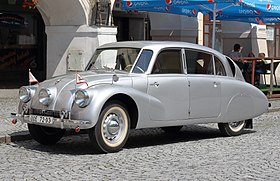Tatra T87
| Tatra T87 | |
|---|---|
 |
|
| Overview | |
| Manufacturer | Tatra |
| Production |
|
| Assembly | Kopřivnice, Moravia, Czechoslovakia |
| Designer | |
| Body and chassis | |
| Class | Luxury car, 5-seater Sedan |
| Body style | limousine (Finned Fastback) |
| Layout | RR layout |
| Powertrain | |
| Engine | 2969 cc (3.0L) Tatra 87 V8 |
| Transmission | 4-speed manual (3 and 4 synchronized) |
| Dimensions | |
| Wheelbase | 2,850 mm (112.2 in) |
| Length | 4,740 mm (186.6 in) |
| Width | 1,670 mm (65.7 in) |
| Height | 1,500 mm (59.1 in) |
| Curb weight | 1,370 kg (3,020 lb) |
| Chronology | |
| Predecessor | Tatra 77a |
| Successor | Tatra 603 |
The Tatra 87 was a car built by Czechoslovak manufacturer Tatra. It was powered by a rear-mounted 3.0-litre air-cooled 90-degree overhead cam V8 engine that produced 85 horsepower and could drive the car at nearly 100 mph (160 km/h). It is ranked among the fastest production cars of its time. Competing cars in this class, however, used engines with almost twice the volume, and fuel consumption of 20 liters per 100 km (11.8 mpg). Thanks to aerodynamic shape the Tatra 87 had a consumption of just 12.5 litres per 100 km (18.8 mpg). After the war between 1950 and 1953 T87s were fitted with more modern 2.5-litre V8 T603 engines.
The 87 was used by Hanzelka and Zikmund for their travel through Africa and Latin America from 1947 to 1950.
The Tatra 87 has a unique bodywork. Its streamlined shape was designed by Hans Ledwinka and Erich Übelacker, and was based on the Tatra 77, the first car designed for aerodynamic purposes. The body design was based on proposals submitted by Paul Jaray of Hungarian descent, who designed the famous German Graf Zeppelin dirigibles. A fin in the sloping rear of the Tatra helps to divide the air pressure on both sides of the car, a technique used in later aircraft. Tatra T87 had a drag coefficient of 0.36 as tested in the VW tunnel in 1979 as well as reading of 0.244 for a 1:5 model tested in 1941.
Small sets of windows in the dividers between the passenger, luggage space and engine compartments, plus louvres providing air for the air-cooled engine, allowed limited rear visibility. Its entire rear segment could be opened, to service the engine. The front doors are "suicide doors" (i.e. rear-hinged doors), whereas the rear doors open in an orthodox manner.
Many design elements of the Tatra 87, Tatra V570 and the later T97 were copied by later car manufacturers. Ferdinand Porsche was heavily influenced by the Tatra 87 and T97 and the flat-four-cylinder engine in his design of the Volkswagen Beetle, and was subsequently sued by Tatra.
...
Wikipedia
